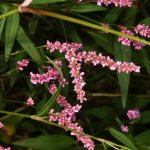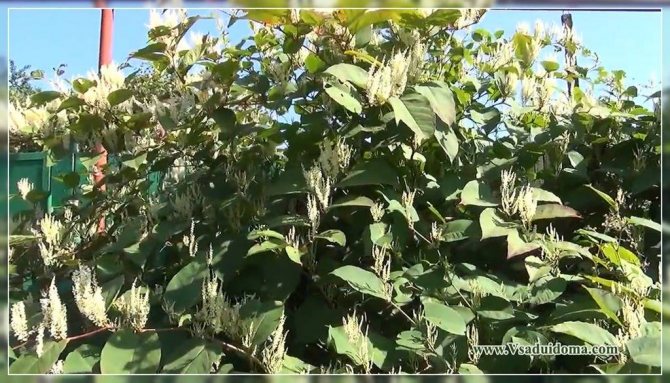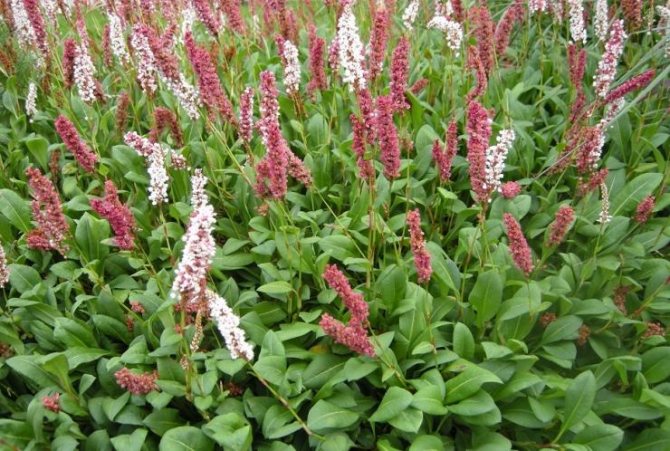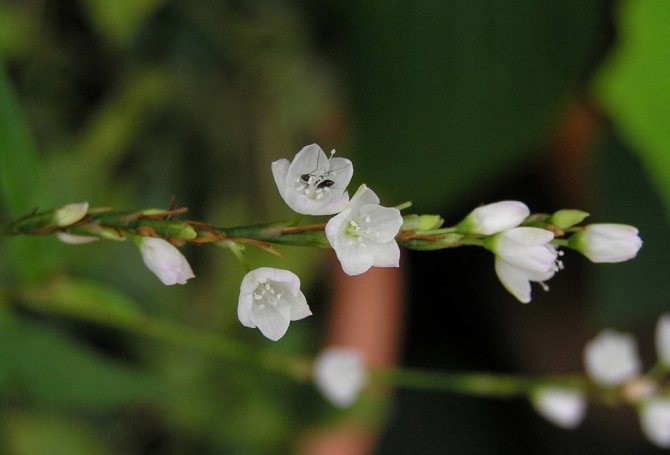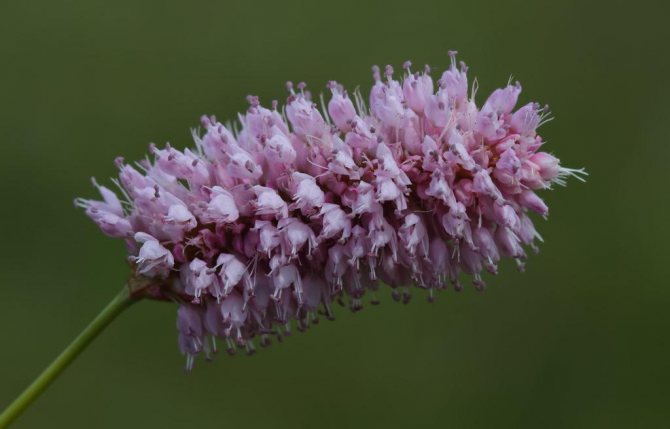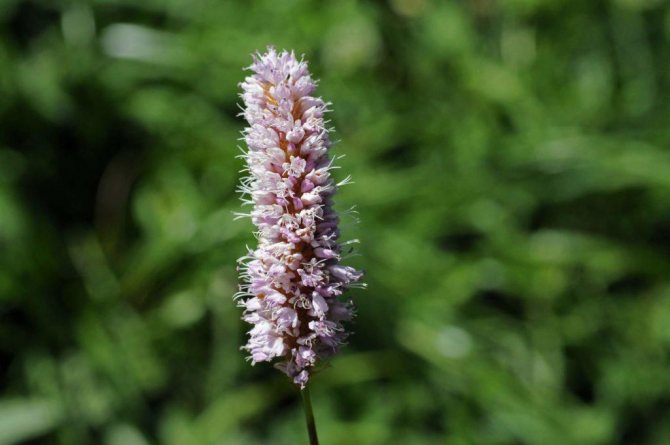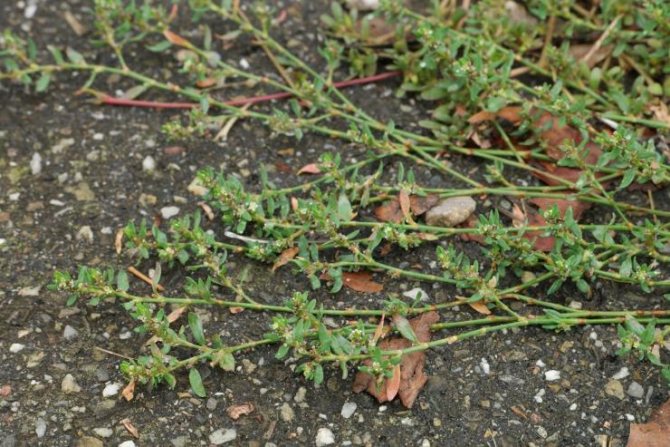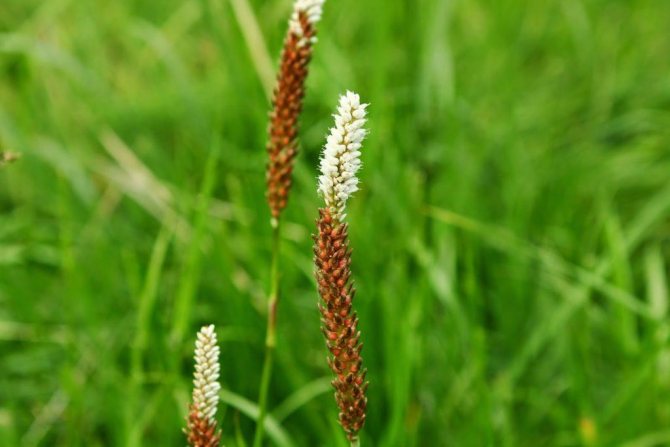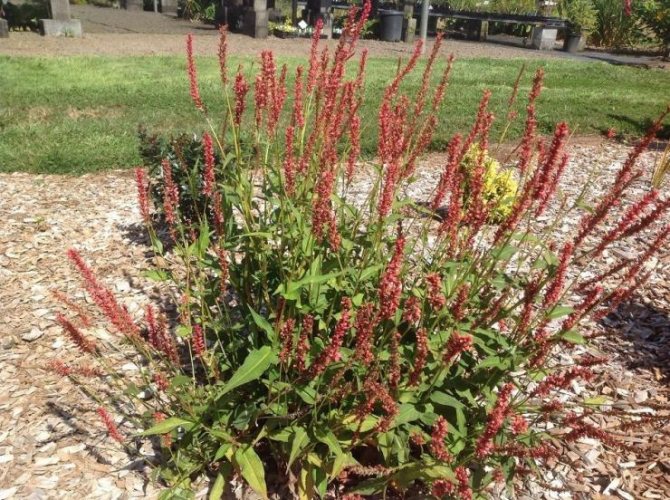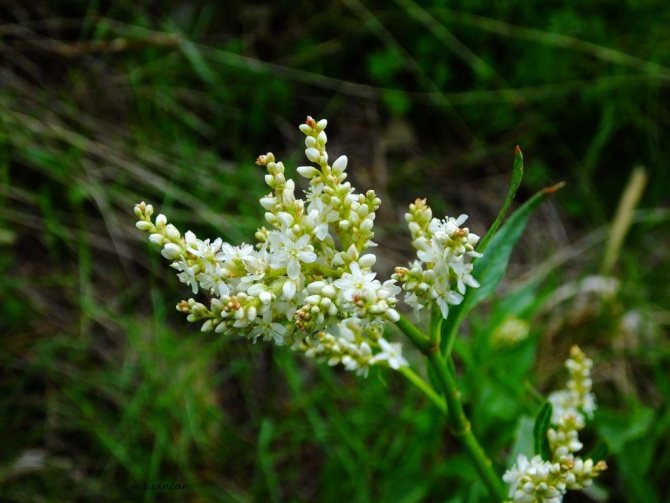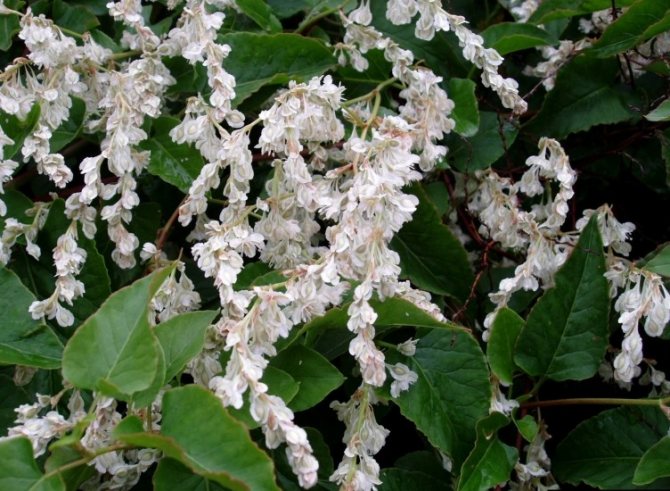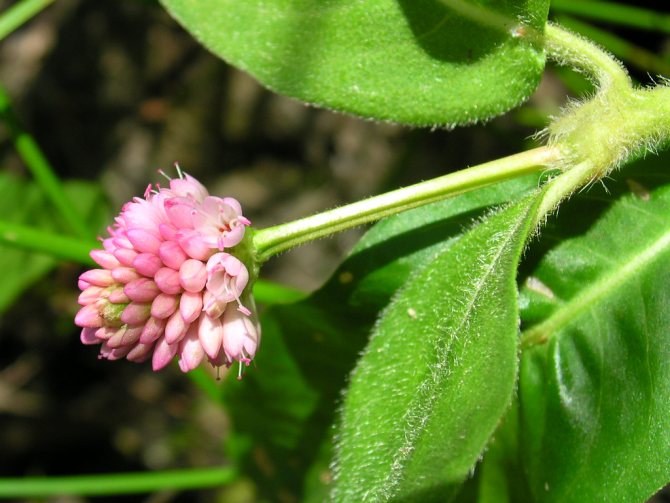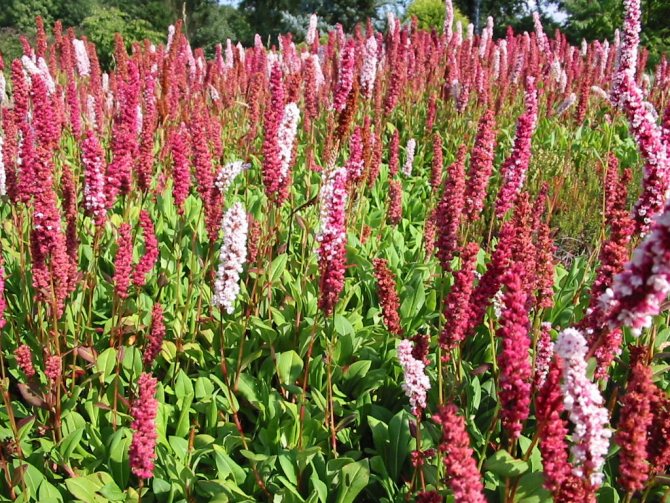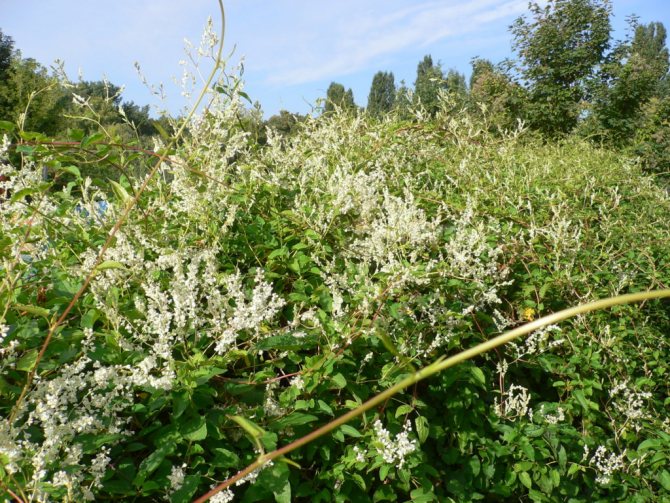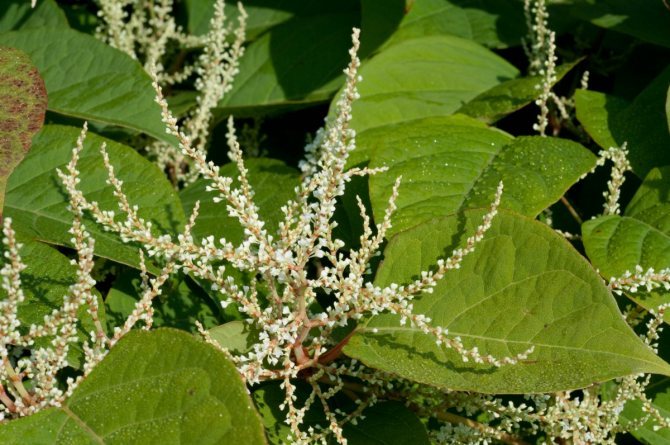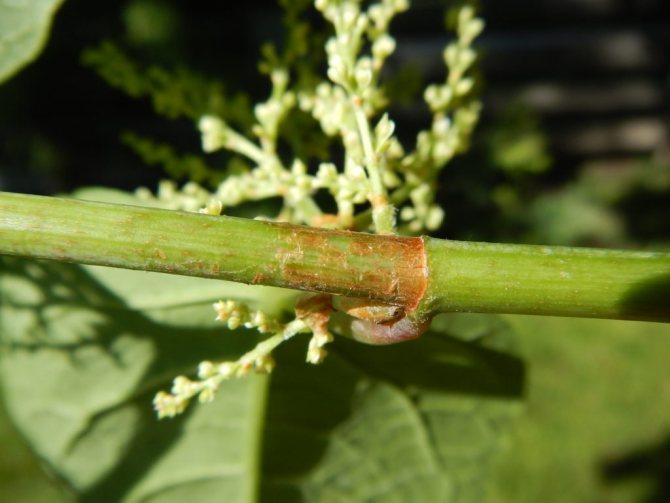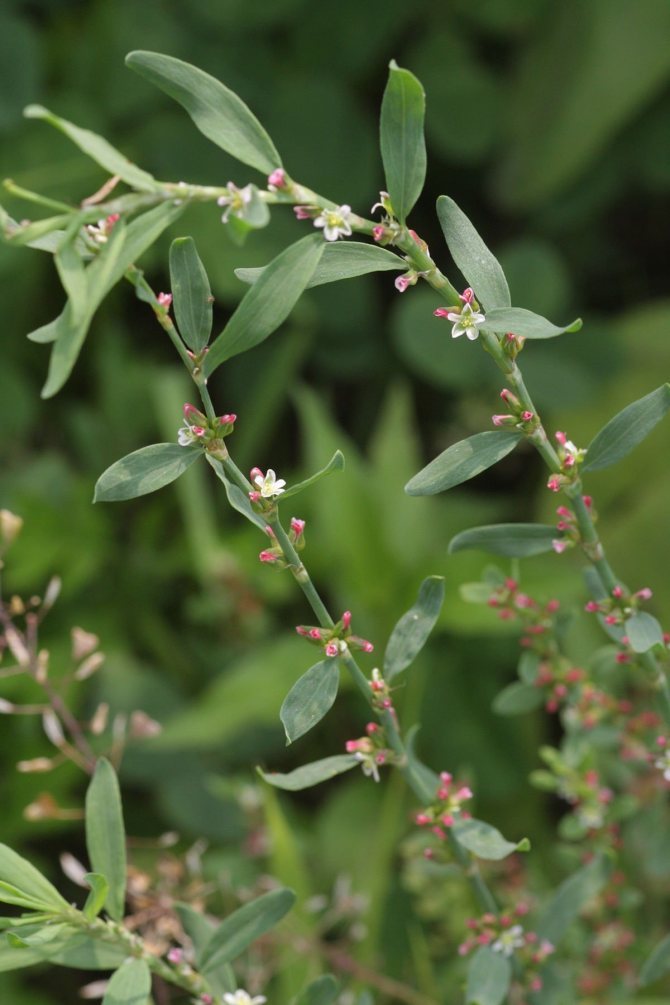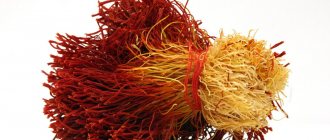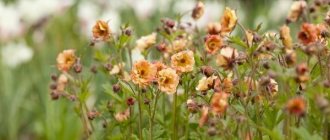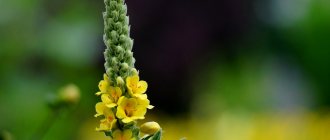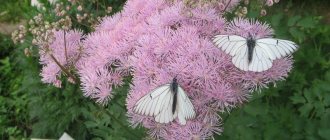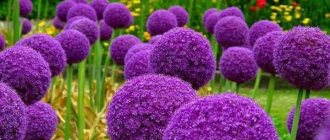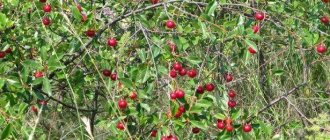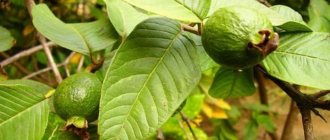Highlander Is a perennial plant of a shrub type belonging to the buckwheat family and is a separate species, consisting of more than two hundred subspecies and varieties. Of all this wonderful variety, about twenty of its varieties and hybrids are cultivated.
In Greek, its name refers to a polygonal figure. The place of origin of the plant is considered to be the region of the Far East and the islands of Japan and the Kuril ridge. Nowadays, it is grown and grows wild almost everywhere, on all continents of the Northern Hemisphere.
What does a highlander look like and its main features

Highlander flower (polygonum) is a perennial herb, belongs to the buckwheat family. In total, there are about 300 different types of mountaineer in the world, 20 of which can be grown at home.
Depending on the species, the mountaineer can be not only herbaceous, but also in the form of a half-shrub and even a creeper. All highlanders have common similarities that unite them into one genus.
Highlander description:
- Stems are open, erect, small flowers, collected in an inflorescence panicle or brush.
- The root system of the mountaineer is well developed, the rhizome is either creeping or erect.
- Leaves are simple lanceolate-ovate, alternate arrangement.
- The fruit of the mountaineer flower is a nut, it contains a large number of seeds.
- The color of flowers can be very diverse, ranging from white to red and burgundy. The flowering period lasts from July to August.
Highlander is very popular in home floriculture. Different types can be used in one composition. For example, the amphibian mountaineer is used to decorate water bodies, it partially submerges in water, and part of it peeps out. The serpentine mountaineer stretches along the shores of reservoirs.
The plant does not like acidic soils, develops well in shaded areas, does not need moisture.
These are ideal conditions for the lazy gardener who does not have time to spend a lot of time on the site, but wants to decorate his garden. If there was little snow in winter, then this may turn out to be negative for the mountaineer. After winter, the highlander will look sloppy, but very soon he will take on his usual shape.
Liana-like highlanders are used for vertical gardening. Herbaceous and semi-shrub species are planted in curbs, rock gardens, etc. Alpine species can be used for specimen plantings.
In nature, the mountaineer is found in the steppes and mountainous areas in the countries of the Northern Hemisphere, in temperate latitudes. The mountaineer endures winter without shelter, he is unpretentious, resembles a weed in its properties, although very decorative.
Some types of mountaineer are even used in folk medicine.
Variety of highlander species


Gardeners most often use the following types of highlander:
- Alpine highlander is a semi-shrub plant. The maximum height is 1.5 meters, the stems can divide and branch to unlimited sizes. The flowers are white, gathered in a panicle. It is the most popular among other species of highlander, as it actively develops and blooms profusely. The flowering period begins in July.
- Highlander is a related herb that covers the ground. The maximum height is no more than 25 cm, the stems are raised above the soil.The plant is evergreen, the leaves can be oval or oblong-lanceolate. The flowers are collected in an inflorescence of spikes, themselves very small, red-pink in color. It begins to bloom in May.
- Highlander Sakhalin, or as it is also called Sakhalin sinner, is a perennial herb. Differs in straight strong stems, can grow up to 3 meters in height, green leaves with a brown tint. The leaves are large, the maximum length is 30 cm, the maximum width is 20 cm. The flowers are small, of a pastel-cream shade, collected in panicles 20 cm long. It begins to bloom in July.
- Knotweed is a shrub plant, the stems grow 80-120 cm in height. The leaves are wide, by autumn they begin to turn yellow. The flowers are collected in a spikelet inflorescence, begins to bloom in August, the flowering period lasts 2 months.
There is another classification, according to which the mountaineers are divided according to the type: tall or short.
Among tall plants, gardeners successfully grow:
- The eastern highlander grows up to 2 meters in height, the inflorescences are large. Flowers can be white, red, pink, lilac. The leaves are pointed, after flowering, large nuts remain. The flowering period lasts from August to the end of autumn. Loves wet soil, does not require special care.
- The Japanese knotweed grows in the form of a bush. Its maximum height is 5 meters. The branches are hollow, resembling bamboo stems, the leaves are oval. The leaf differs in that light streaks are located on it. It begins to bloom at the end of September. In one season, a Japanese highlander can create an entire hedge.
Low-growing species:
- The capitate mountaineer is an annual plant that grows rapidly and covers the ground. The maximum height is 15 cm, the leaves have red streaks and spots. Inflorescences in the form of cones, small, not particularly prominent, pink flowers.
- Viviparous mountaineer - perennial, grows up to 45 cm. Stems are straight, leaves are dense, dark in color. Inflorescence of spikes, pink or red flowers, blooms throughout the season. The roots and flowers are eaten.
- Highlander Baldzhuan - grows in the form of a vine. The length of each shoot reaches 12 meters in length. The main application of this type of mountaineer is vertical gardening. As the plant grows older, the stems become lignified. The flowers are small, pink in color. Leaves are dark green. The plant needs to be watered regularly, it loves moisture and cool air. The plant tolerates even the coldest winter, the vines freeze out, but the roots remain and give new shoots.
Each species is significantly different from the rest. You can understand belonging to the genus by typical inflorescences.
Types used in traditional medicine
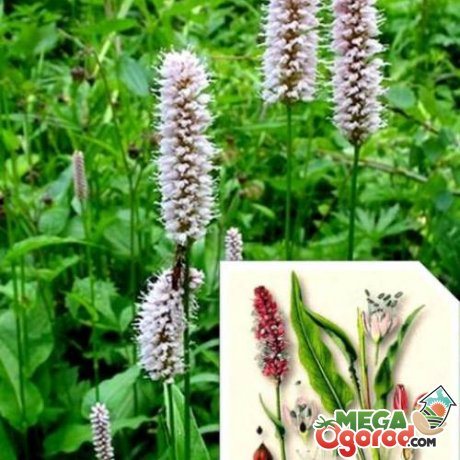

Highlander is used in folk medicine for a wide range of diseases. The plant treats eye diseases, problems of the gastrointestinal tract, gout.
The main properties of the highlander:
- Bactericidal.
- Astringent.
- Wound healing.
The most healing of all types are alpine and serpentine mountaineers. The serpentine knotweed (crayfish necks, viper grass, veal tongue) has small flowers and a hollow stem. Flowers are collected in a spikelet inflorescence, can be red, pink and white.
You can grow a snake highlander on moist soil in a bright place. Under natural conditions, it grows in meadows and mountainous areas. The maximum plant height is no more than 1 meter. For the preparation of medicinal recipes, all parts of the plant are used: roots, stems, leaves, flowers and seeds.
Raw materials are harvested in May, then it will have the most healing properties.
Highlander is a strong antiseptic that can stop bleeding and relieve inflammation:
- The snake mountaineer is indispensable for indigestion, for diseases of the gastrointestinal tract, gallbladder, for problems with the throat, oral cavity, for the healing of boils and purulent wounds.
- Alpine highlander (battering ram, kislets, mountain highlander) is a weed, although it is grown as an ornamental plant.Bushes are wide and branched, up to 2 meters in diameter. The roots are large, penetrate deep into the ground. The flowers are white, gathered in a panicle inflorescence. The flowering period begins in mid-summer and can be found in meadows, steppes and even forests. It spreads quickly and requires little maintenance.
- Alpine mountaineer is used in the treatment of diseases of the stomach and intestines, diarrhea, dysentery, high blood pressure. The stems and leaves of plants contain a large amount of vitamin C, so they are used to treat colds and raise immunity.
- Bird knotweed (knotweed) grows in urban conditions, is not afraid of dust and trampling. The herb has a diuretic and astringent, stops bleeding. Water infusions using Knotweed are used for diseases of the gastrointestinal tract, diarrhea, diseases of the bladder, tuberculosis, whooping cough, etc.
Knotweed baths fight skin diseases, relieve bruise pain, and heal wounds.
Fresh herb extract is used as a homeopathic remedy. Despite the fact that the mountaineer is an aggressive weed plant, it is very decorative and very useful.
Medicinal properties
Much of the traditional medicinal benefits of Highlander have been derived from the high tannic acid content combined with the presence of gallic acid, gums, and starches. Highlander is known to be highly astringent, which helps in contact with bodily tissues and reduce mucus. The plant can also help with some digestive problems such as:
- diarrhea;
- reducing mouth irritation by reducing swelling;
- if necessary, softening and lubricating bodily tissues;
- act as a mild diuretic;
- in wound healing as direct application;
- and it also has a hemostatic effect that can help reduce internal bleeding.
However, no clinical trials have been conducted to investigate the efficacy of the Highlander related.
Traditionally, boiled roots were used to make wine, which was then used to treat dysentery and diarrhea, inhibiting vomiting, controlling excessive menstruation, and treating inflammation of the mouth and throat. During Shakespeare's time, the Highlander sibling was used to treat nasal polyps. It was also widely used as a mouthwash and had a good reputation as a useful herb for "fixing loose teeth."
The plant also contains oxalic acid, which is not a direct toxin. However, when consumed in large quantities, it binds large amounts of minerals and nutrients to make them inaccessible to the body. This leads to mineral deficiencies and can cause serious problems. Cooking herbal ingredients reduces the oxalic acid content, similar to the need to cook sorrel and rhubarb.
The tannins in this plant can absorb and reduce the effectiveness of certain drugs by binding them in the stomach. Take your medication at least one hour before consumption. Also note that consuming the Highlander sibling can aggravate rheumatism, gout, arthritis, and kidney stones.
Culinary use
The related highlander is traditional for food, so in Russia, Iceland and Siberia, plants were consumed as a food source during famine. However, this is not one of the main reasons for the popularization of the plant. All parts of the Highlander are edible and can be used in cooking. The rhizome is known to have a high starch content and is considered very tasty and nutritious. It was used during times of famine to provide a high calorie intake when other foods were unavailable.
The reddish roots can be treated like potatoes and used in soups, stews, or simply roasted.They can also be dried and ground into powder for use in making bread flour. The roots should be immersed in water before drying to reduce the tannin content. The leaves taste bitter, although the young leaves are less bitter and can be used as a substitute for spinach. Knotweed is the main ingredient in the "bitter lean pudding" made for Easter in Northern England.
Growing and care
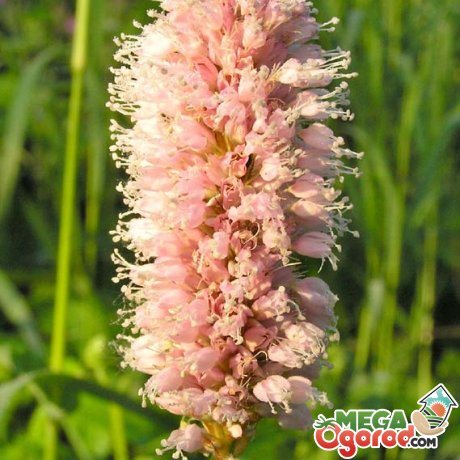

It is not difficult to grow a mountaineer. All species have similar characteristics, however, many of them require special conditions. Highlander adapts well to cool conditions, he will actively grow and develop in partial shade, in conditions of high humidity. Highlander blooms best on fertile, moist soils, the choice should be on fertilized sandy loam or loamy soils, the reactions are slightly acidic or neutral.
The mountaineer himself looks like a weed, so he is not afraid of pests.
It is resistant to the most common diseases. The Knotweed prefers alkaline or neutral soils. The serpentine mountaineer is more fond of areas to which groundwater is close. But the splayed mountaineer, on the contrary, loves drier areas, that is, moderately moist.
Plant care secrets:
- During the summer season, plants are provided with moderate watering. Some species require abundant watering if there is no groundwater nearby.
- The mountaineer has a good attitude towards fertilizers.
- It can tolerate drought and slight waterlogging, but being constantly in damp ground will feel bad.
- Young highlanders can hardly endure autumn or spring frosts. Therefore, young plants are covered until summer. If the leaves have died during the autumn frost, then the stems must be cut off immediately.
- In autumn, the leaves on some species begin to turn yellow, in this state they are all winter. With the onset of spring, the brown leaves are cut off, and at the end of autumn the entire plant is cut off.
- The first year, a young plant requires shelter for the winter. If Japanese, filamentous or small-headed knotweed is grown, then they spend the winter not in open ground, but in greenhouses.
There is another property of the mountaineer, for which some gardeners love him, and some refuse to grow. We are talking about strong overgrowth, even aggressiveness.
In one season, the shoots of a mountaineer can spread far beyond the bush, flesh up to several meters.
It is sometimes difficult to keep the plant within its limits. It must be constantly trimmed and weeded out, or you can watch the flower fill most of the garden. The main requirements relate to the choice of soil, illumination and moisture. Everyone can provide them.
Growth conditions
The Knotweed can be grown in a wide variety of soils, even where the land does not need good drainage. It grows very well in humid areas near large streams, ponds or the edges of small streams, but it may need to be controlled in these areas. Because if left to grow unattended, it will spread on a large scale. As long as water is supplied, the plant will tolerate warm conditions, but its northern hemisphere origins allow it to withstand temperatures as low as minus 25 C.
Knotweed will grow in full sun and partial shade, but if your garden is very warm or hot, choose partial shade. When there is not enough water, the plant will not flower well, so it is better to provide moist soil. If the conditions are too dry, the plant will dormant for a while. Pink flower buds appear in spring and summer, or from November to March in Australia, for example. The seeds ripen from February to April.Roots can be dug up in the fall for drying (cut long roots in half) or for current use. Leaves are best picked and used when young.
To grow the Knotweed, you can sow the seeds in the spring when the temperature is 18-24 ° C, directly in the ground or in trays if you are in cold regions. Seedlings can be potted and planted in the garden when the ground is warm enough. Seedlings can be taken from 21 to 60 days, but if not, cultivation can be done from seed, which is a fairly simple method. In warmer areas where there is no true cool season, it may be helpful to adjust to the seasons by refrigerating the seeds for a period of time. Mature lumps can be split so they can be planted elsewhere in the garden, or simply to support growth.

